Subscribe to EDOM TECH Newsletter
ROHM
2021/12/13
ROHM’s New 13.56MHz Wireless Power Supply Chipset up to 1W
Providing wireless charging and communication functions with a single chipset
ROHM Group company LAPIS Technology developed a chipset capable of providing up to 1W of wireless power for compact and streamlined wearable devices, and for industrial smart, miniaturized and sealed solution. The ML7661 (transmitter) and ML7660 (receiver) eliminate the need for an external MCU by incorporating a control circuit required for transmission/reception, resulting in the industry’s smallest system size in the 1W class. This makes it ideal for wearables with a large battery capacity designed to be worn for long time frames. Typical products are wristband blood pressure monitors, fitness trackers, smart watches, and hearing aids, for example. Moreover, the adoption of the high 13.56MHz frequency band enables the support for Near Field Communication (NFC).
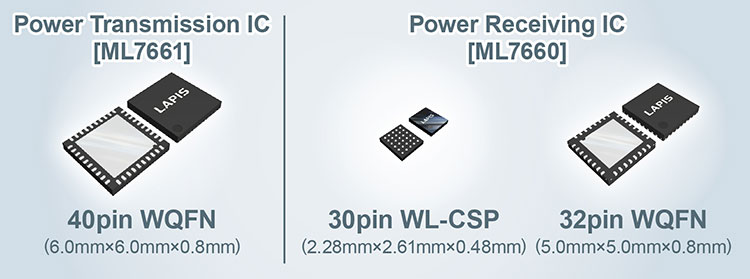
Providing wireless power and communication in a single chipset contributes to improved design flexibility in devices with rotating mechanisms that would normally be restricted by wired designs –such as industrial equipment, PC cooling fans, and e-bike torque sensors.
In recent years, there has been a growing need to improve the safety of compact electronics (especially small medical devices) against electric shock. Wireless power supply eliminates the need for a power cord, significantly improving safety during charging or sweating by increasing the waterproof, dustproof, and (electric) shockproof performance of sealed housings. However, although the Qi standard is widely used and can supply up to 15W, the system size which includes the chipset and antenna is also typically large, making it difficult to incorporate into wearable devices.
In response, ROHM Group company LAPIS Technology previously developed the ML763x chipset that utilizes the 13.56MHz frequency band to deliver 200mW of power and enable communication wirelessly. But while it was well-received by the market, there were calls for increased power to support wearables with large battery capacities such as wristband blood pressure monitors, smart watches, and hearing aids. ROHM’s latest chipset meets this need by providing a power capacity up to 1W in a compact form factor, expanding the application range.
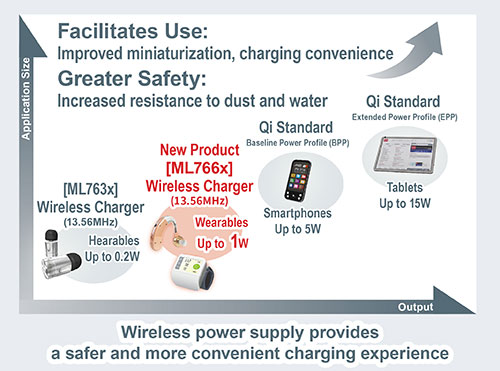
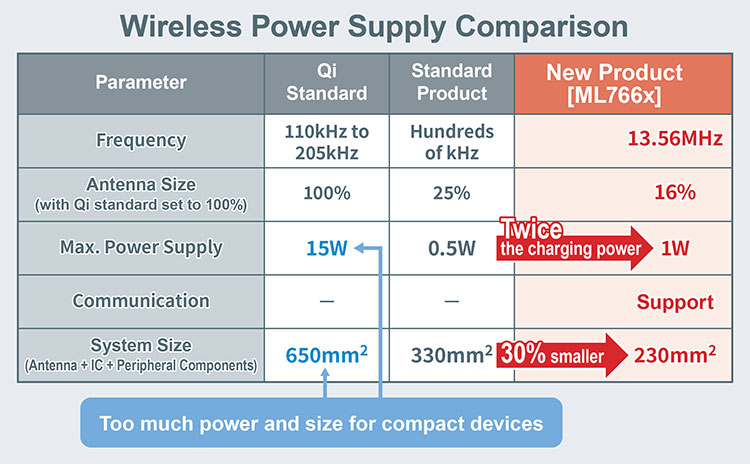
Key Features
1. Delivers up to 1W of power in the industry’s smallest system size
ROHM’s new chipset achieves wireless power supply up to 1W by optimizing power transmission control according to the amount of power required while suppressing heat generation of the IC itself. In addition, adopting the high 13.56MHz frequency band for power supply allows the antenna to be made smaller, reducing system size by 30% over standard products – ideal for compact devices such as wristband blood pressure monitors, smart watches, and hearing aids. What’s more, a communication protocol is built in that supports both I2C and SPI interfaces, enabling control of digital sensors and other devices without an MCU. Eliminating the mounting area required for the MCU results in the industry’s smallest system size (even compared with general 1W class power supplies).
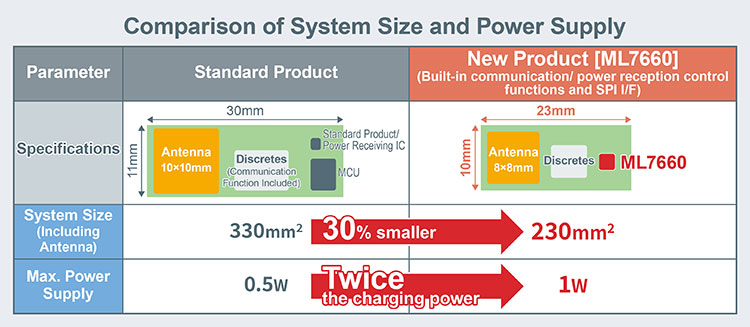
2. Enabling both wireless power supply and communication contributes to improved application design flexibility
ROHM’s new chipset utilizes the 13.56MHz frequency band for both wireless power supply as well as Near Field Communication (NFC). Providing contactless power and communication with a single chipset contributes to improved design flexibility in devices with rotating mechanisms that would be restricted by wired designs, such as industrial equipment, PC cooling fans, and e-bike torque sensors. In addition, adopting a unique communication format reduces the communication interval from 4ms with the ML763x to just 1ms in the ML766x, making it possible to improve real-time rotational speed control and monitoring.
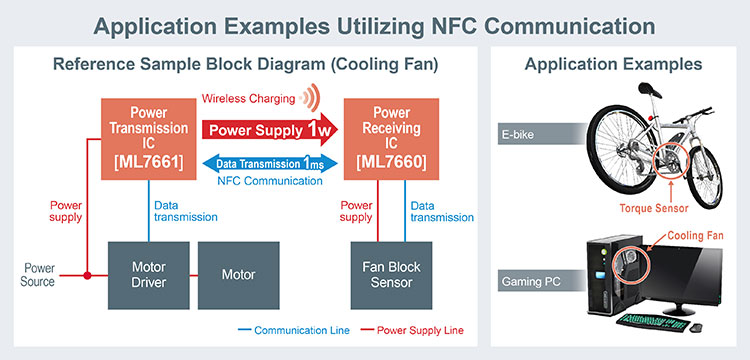
3. MCU-less system configuration reduces development load
ROHM’s new chipset facilitates system configuration by adjusting power transmission to increase power supply efficiency and setting parameters such as temperature thresholds according to the specifications of the rechargeable battery. This eliminates the need for a system control MCU along with the requisite program development, reducing development load considerably. At the same time, a low power consumption mode is included that significantly decreases power consumption during system standby.
Development Support
An evaluation kit is available that makes it easy to immediately begin evaluation of this new 13.56MHz wireless power supply chipset. ROHM supports the configuration of charging systems that meet various customer requirements. For example, tools for individual user settings from a PC along with documents related to antenna design and adjustment are available. Click on the URL below for more information:
https://www.lapis-tech.com/en/semicon/wpt/landing/ml7660_61.html
Product Specifications

Applications
- Medical wearable devices up to Class 2: Hearing aids, wristband blood pressure monitors
- Wearables: Smart glasses/watches
- Rotating equipment: Cooling fans, e-bike torque sensors
Availability: September 2021 (samples), April 2022 (mass production)
Terminology
Near Field Communication (NFC)
A short-range wireless communication technology that uses the 13.56MHz band. Specifications are defined by the NFC Forum, an industry standards organization. ROHM is an associate member of the NFC Forum.
Qi Standard
An international standard for wireless power transfer developed by the Wireless Power Consortium. Often adopted for wirelessly charging smartphones.
I2C/SPI Interfaces
Both I2C, an abbreviation for Inter-Integrated Circuit and SPI, short for Serial Peripheral Interface, are synchronous serial communication methods used to connect devices inside a computer. Unlike asynchronous serial communication, they can connect multiple slaves and transmit at high speeds.
Torque Sensor
A sensor that converts the magnitude of force (torque) during rotation into electrical signals. On an e-bike, it is used to detect the amount the pedal is depressed and feed it back to the motor.






